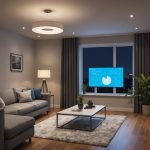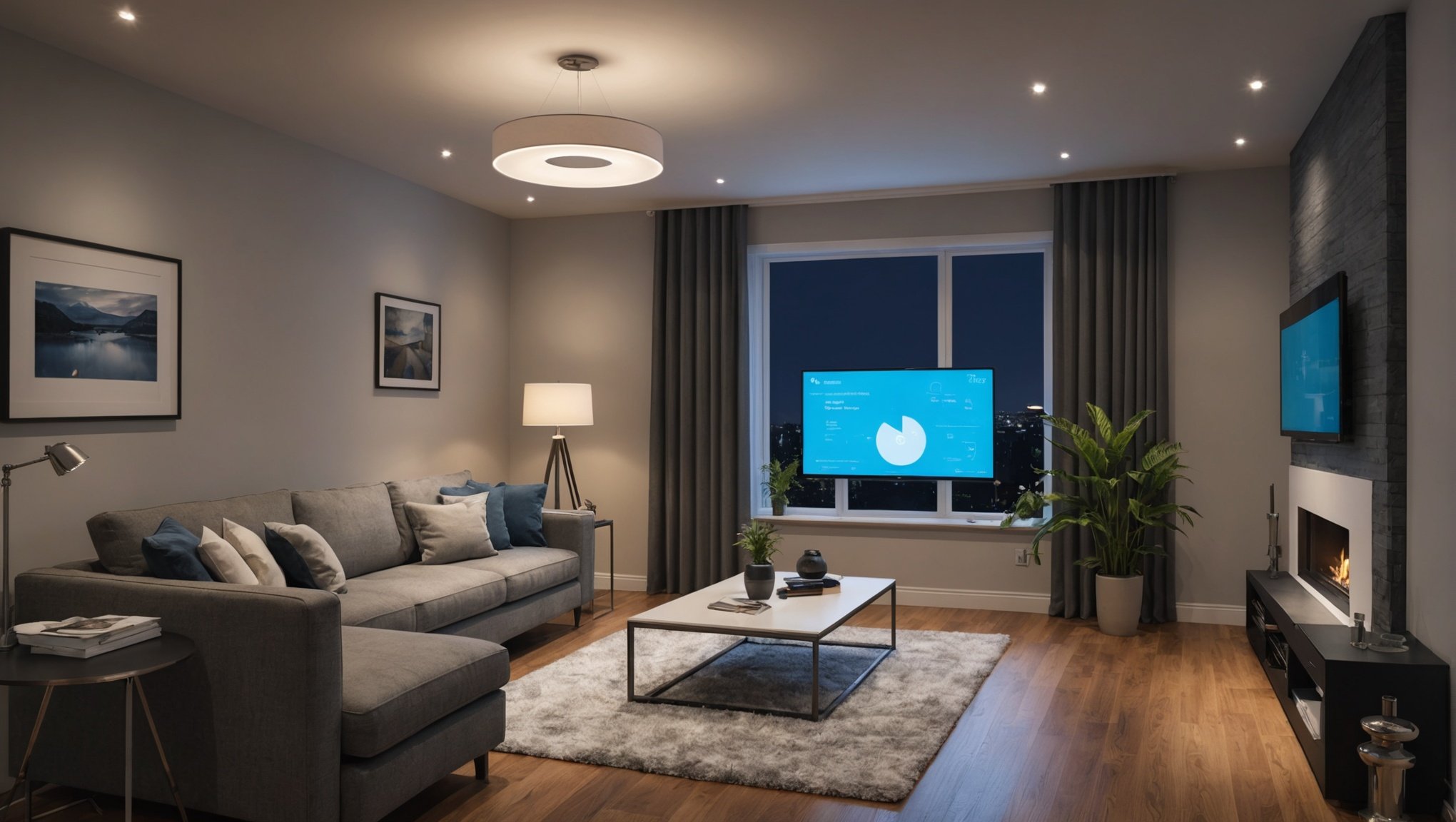Smart home lighting enhances both convenience and ambiance, revolutionizing how you interact with your living space. Voice command setup offers a seamless experience, allowing quick adjustments without the hassle of switches. This guide provides practical tips on selecting the right devices, configuring them effectively, and mastering voice commands for effortless management. Whether you're a tech novice or a seasoned enthusiast, discover how to optimize your smart lighting for comfort and efficiency. Explore the transformative power of voice-integrated technology and create the perfect atmosphere with just your voice.
Understanding Smart Home Lighting Systems
Smart home lighting is a key component of modern home automation, offering convenience and efficiency. With smart lighting, users can control their lights remotely through apps or voice control systems like Alexa or Google Assistant. This technology not only enhances comfort but also contributes to energy savings.
Have you seen this : Maximize Your Smart Home: A Guide to Tracking Solar Panel Energy Production with Your Smartphone
There are various types of smart lighting systems available. Wi-Fi-enabled bulbs are popular, allowing seamless integration with existing home networks. These bulbs can be controlled individually or in groups, providing flexibility. Another type is the Zigbee or Z-Wave systems, which require a hub but offer a more reliable connection, especially in larger homes.
The benefits of incorporating smart lighting into home automation are numerous. Voice control allows for hands-free operation, which is particularly useful in situations where manual control is inconvenient. Additionally, smart lighting systems can be programmed to operate on schedules, enhancing security by simulating presence when you're away. They also contribute to energy efficiency by allowing precise control over lighting levels and usage.
Also read : Elevate Your Travel Planning: Crafting and Sharing Interactive Itineraries with Your Smartphone
In summary, smart home lighting systems represent a significant advancement in home automation, offering both practical and environmental benefits. Understanding the types and advantages of these systems can help users make informed decisions to enhance their living spaces.
Voice Command Compatibility
In the realm of smart home lighting, compatibility with voice command systems is a significant feature. Popular smart assistants such as Alexa, Google Assistant, and Siri have revolutionised how we interact with our home environments. These assistants allow users to control lighting systems through simple voice commands, offering unparalleled convenience.
When considering compatibility, it's crucial to ensure that your chosen smart lighting system supports the voice assistant you prefer. Most Wi-Fi-enabled bulbs and Zigbee or Z-Wave systems offer broad compatibility, but it's essential to verify this before making a purchase. Check the product specifications or consult the manufacturer's guidelines to ensure seamless integration.
For a smooth experience, consider the following factors:
- Network stability: A reliable internet connection is vital for uninterrupted communication between your smart assistant and lighting system.
- Device compatibility: Ensure all devices are updated to the latest firmware to avoid compatibility issues.
- Command recognition: Familiarise yourself with the specific voice commands supported by your lighting system for optimal performance.
By focusing on these elements, you can enhance your home's automation experience, making it both efficient and user-friendly.
Setting Up Smart Home Lighting
Setting up a smart home lighting system involves several key steps to ensure optimal performance and integration.
Pre-Installation Considerations
Before beginning the setup process, assess your home's current lighting infrastructure. Determine if you need additional equipment like hubs for Zigbee or Z-Wave systems. Ensure your Wi-Fi network is stable, as it plays a crucial role in the installation and operation of smart lighting.
Step-by-Step Installation Guide
- Gather Essential Tools: Have a stable internet connection, a smartphone or tablet, and any required hubs or bridges.
- Install Smart Bulbs: Replace existing bulbs with smart ones, ensuring compatibility with your fixtures.
- Download the App: Install the manufacturer's app on your device to facilitate the configuration process.
- Connect to Wi-Fi: Follow the app's instructions to connect the bulbs to your home network.
- Test the System: Turn the lights on and off via the app to confirm successful installation.
Configuring Smart Lighting with Voice Commands
To integrate voice commands, ensure your smart assistant is set up and linked to your smart lighting system. In the app, navigate to the voice assistant settings and follow the prompts to connect. This enables you to control your lights hands-free, enhancing convenience and functionality.
Managing Smart Home Lighting via Voice Commands
Harnessing the power of voice commands transforms how we manage smart lighting control in our homes. By simply speaking, users can perform a variety of tasks, enhancing convenience and efficiency.
Common Voice Commands for Smart Lighting
Users typically employ straightforward voice commands such as "turn on the lights," "dim the lights," or "set the lights to 50%." These commands make controlling individual bulbs or entire rooms effortless. For more specific adjustments, you might say, "change the living room lights to blue," providing a customised lighting experience.
Creating Lighting Routines and Scenes
Voice commands also enable the creation of lighting routines and scenes. By saying, "activate movie scene," you can adjust multiple lights to predefined settings, perfect for setting the mood. Routines can be scheduled to activate at certain times, like "good morning" to slowly brighten lights.
Adjusting Settings and Preferences Using Voice
Adjusting settings with voice commands is straightforward. Users can modify preferences by stating, "set bedroom lights to warm white," or "increase brightness by 20%." This level of control allows for a tailored lighting environment, adapting to your lifestyle needs seamlessly.
Troubleshooting Smart Home Lighting Issues
Smart home lighting systems can occasionally face issues that disrupt their seamless operation. Identifying and addressing these common problems is crucial for maintaining an efficient system.
Identifying Common Smart Lighting Issues
Frequent issues include connectivity problems, where bulbs fail to connect to the network, or inconsistent performance, such as lights not responding to commands. Other common problems are flickering lights and incorrect colour settings.
Step-by-Step Troubleshooting Tips
- Check Connectivity: Ensure your Wi-Fi is stable and devices are within range. Restart your router if necessary.
- Inspect Bulbs: Verify that bulbs are securely fitted and compatible with your system.
- Update Firmware: Keeping your device firmware up-to-date can resolve many issues.
- Reset Devices: Sometimes, a simple reset can fix persistent problems. Follow the manufacturer's instructions for resetting.
- Review App Settings: Ensure the app settings are correctly configured and permissions are granted.
When to Seek Professional Help
If issues persist after troubleshooting, it may be time to consult a professional. They can provide expert assistance, especially for complex systems like Zigbee or Z-Wave, ensuring your smart lighting operates smoothly.
Recommended Smart Lighting Products
Exploring the world of smart lighting products can be both exciting and overwhelming due to the plethora of options available. To simplify your decision-making process, we've compiled a list of top-rated smart lighting products that stand out in terms of features, price, and user satisfaction.
Overview of Top-Rated Products
Philips Hue is a leading brand, renowned for its extensive range of bulbs, light strips, and fixtures. Their products offer seamless integration with major smart home systems and provide a wide spectrum of colours and dimming capabilities. LIFX, another popular choice, boasts vibrant colours and does not require a hub, making it a convenient option for those seeking simplicity.
Comparison of Features and Prices
When comparing features, Philips Hue offers robust app control and compatibility with Zigbee, while LIFX provides superior brightness and direct Wi-Fi connectivity. Price-wise, Philips Hue is often more expensive due to its extensive ecosystem, whereas LIFX offers competitive pricing with excellent performance.
User Reviews and Testimonials
Users frequently praise Philips Hue for its reliability and versatility, highlighting its ability to create complex lighting scenes. LIFX receives accolades for its vibrant colours and ease of setup, making it a favourite among those who prefer a straightforward installation process.
User Scenarios and Practical Applications
Smart lighting systems offer versatile user scenarios that cater to various needs, enhancing convenience and enriching daily life. Families, for instance, can utilise smart lighting to simplify their routines. Imagine a busy morning where lights gradually brighten to simulate sunrise, gently waking everyone up. This practical application not only eases the morning rush but also ensures an energised start to the day.
Enhancing Security with Smart Lighting
Smart lighting plays a crucial role in home security. By automating lights to turn on and off at specific times, homes can appear occupied even when residents are away. This real-life example of using smart lighting as a deterrent to potential intruders highlights its importance in safeguarding properties. Additionally, integrating motion sensors can trigger lights to illuminate unexpected movements, further enhancing security measures.
Creating Ambiance for Different Occasions
Smart lighting allows users to tailor ambiance to suit various occasions. Whether hosting a dinner party or enjoying a quiet movie night, adjusting light colours and intensities can transform spaces. For instance, setting warm hues for a cosy atmosphere or vibrant colours for a festive gathering exemplifies the practical applications of smart lighting in creating the perfect environment.
Visual Aids and Resources
Incorporating visual aids is crucial for comprehending the setup and functionality of smart home lighting systems. These aids, such as diagrams and step-by-step illustrations, simplify complex processes, making them accessible even to beginners. Visuals can demystify the installation process by breaking it down into manageable steps, ensuring a smoother experience.
For those seeking further guidance, numerous online tutorials and videos are available. These resources provide practical demonstrations, offering insights into both basic and advanced features of smart lighting systems. Watching these tutorials can be particularly beneficial for visual learners, as they illustrate real-world applications and troubleshooting techniques.
Additionally, exploring additional resources can enhance your understanding and decision-making. Many manufacturers offer detailed guides and FAQs on their websites, addressing common questions and providing solutions. While links to these resources cannot be provided here, a simple search on the manufacturer's website or popular video platforms can yield valuable information.
By leveraging these visual aids and resources, users can confidently navigate the world of smart lighting, ensuring an efficient and enjoyable home automation experience.
Future Trends in Smart Home Lighting
The world of smart home technology is rapidly evolving, and innovations in smart lighting are at the forefront. Emerging technologies are set to transform how we interact with our home environments. One such advancement is the integration of Artificial Intelligence (AI), which promises to enhance personalisation and efficiency. AI-driven systems can learn user preferences over time, automatically adjusting lighting to suit individual needs and routines.
Looking ahead, the future of home automation will likely see greater connectivity across devices, creating a more cohesive and intuitive experience. Smart lighting systems may become even more integrated with other smart home technologies, such as security and energy management systems, offering a holistic approach to home automation.
Predictions for the future also include the development of more energy-efficient lighting solutions, such as advanced LED technologies and solar-powered options. These innovations aim to reduce environmental impact while providing superior performance.
As these future trends continue to unfold, users can expect a seamless blend of technology and convenience, making everyday life more comfortable and efficient. The role of AI and emerging technologies will be pivotal in shaping the smart homes of tomorrow.










